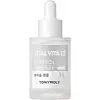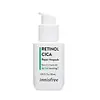What's inside
What's inside
 Key Ingredients
Key Ingredients

 Benefits
Benefits

 Concerns
Concerns

 Ingredients Side-by-side
Ingredients Side-by-side

Water
Skin ConditioningButylene Glycol
HumectantGlycerin
HumectantNiacinamide
SmoothingPEG/PPG-17/6 Copolymer
SolventBis-PEG-15 Methyl Ether Dimethicone
EmulsifyingHydroxyacetophenone
AntioxidantPEG-60 Hydrogenated Castor Oil
Emulsifying1,2-Hexanediol
Skin ConditioningPanthenol
Skin ConditioningCarbomer
Emulsion StabilisingCentella Asiatica Extract
CleansingEthylhexylglycerin
Skin ConditioningTromethamine
BufferingXanthan Gum
EmulsifyingPortulaca Oleracea Extract
Skin ConditioningAdenosine
Skin ConditioningSodium Hyaluronate
HumectantCamellia Sinensis Leaf Extract
AntimicrobialDisodium EDTA
Chamomilla Recutita Flower Extract
MaskingVitex Agnus-Castus Extract
AstringentMelaleuca Alternifolia Leaf Oil
AntioxidantBiotin
AntiseborrhoeicArctium Lappa Root Extract
Skin ConditioningPhellinus Linteus Extract
Skin ConditioningCitrus Aurantium Bergamia Fruit Oil
MaskingEucalyptus Globulus Leaf Oil
PerfumingSqualane
EmollientSoluble Collagen
HumectantCetyl Ethylhexanoate
EmollientNeopentyl Glycol Diheptanoate
EmollientRosmarinus Officinalis Leaf Oil
MaskingPueraria Thunbergiana Root Extract
Skin ConditioningPaeonia Albiflora Root Extract
Skin ConditioningCnidium Officinale Root Extract
Skin ConditioningGlycyrrhiza Glabra Root Extract
BleachingAloe Barbadensis Leaf Juice
Skin ConditioningHydrogenated Phosphatidylcholine
EmulsifyingPEG-35 Castor Oil
EmulsifyingSalvia Sclarea Oil
MaskingPolyglyceryl-10 Myristate
Skin ConditioningCalcium Pantothenate
Maltodextrin
AbsorbentSodium Starch Octenylsuccinate
AbsorbentStearic Acid
CleansingPolyglyceryl-2 Stearate
EmulsifyingCetearyl Alcohol
EmollientAesculus Hippocastanum Seed Extract
Skin ConditioningCrithmum Maritimum Callus Culture Filtrate
Skin ProtectingAlcohol
AntimicrobialSodium Ascorbyl Phosphate
AntioxidantOenothera Biennis Oil
EmollientCarthamus Tinctorius Seed Oil
MaskingOctyldodecanol
EmollientTocopheryl Acetate
AntioxidantPyridoxine Hcl
Skin ConditioningPolysorbate 20
EmulsifyingPolyquaternium-51
Skin ConditioningCeramide NP
Skin ConditioningLactic Acid
BufferingPvp
Emulsion StabilisingTocopherol
AntioxidantSodium Acetate
BufferingLecithin
EmollientLysine
Skin ConditioningInositol
HumectantRetinyl Palmitate
Skin ConditioningSalicylic Acid
MaskingGlycolic Acid
BufferingLinoleic Acid
CleansingSilica
AbrasiveOligopeptide-1
Skin ConditioningFullerenes
AntimicrobialGlyceryl Arachidonate
EmollientGlyceryl Linolenate
EmollientFolic Acid
Skin ConditioningPyridoxine
Skin ConditioningThiamine Hcl
MaskingCyanocobalamin
Skin ConditioningWater, Butylene Glycol, Glycerin, Niacinamide, PEG/PPG-17/6 Copolymer, Bis-PEG-15 Methyl Ether Dimethicone, Hydroxyacetophenone, PEG-60 Hydrogenated Castor Oil, 1,2-Hexanediol, Panthenol, Carbomer, Centella Asiatica Extract, Ethylhexylglycerin, Tromethamine, Xanthan Gum, Portulaca Oleracea Extract, Adenosine, Sodium Hyaluronate, Camellia Sinensis Leaf Extract, Disodium EDTA, Chamomilla Recutita Flower Extract, Vitex Agnus-Castus Extract, Melaleuca Alternifolia Leaf Oil, Biotin, Arctium Lappa Root Extract, Phellinus Linteus Extract, Citrus Aurantium Bergamia Fruit Oil, Eucalyptus Globulus Leaf Oil, Squalane, Soluble Collagen, Cetyl Ethylhexanoate, Neopentyl Glycol Diheptanoate, Rosmarinus Officinalis Leaf Oil, Pueraria Thunbergiana Root Extract, Paeonia Albiflora Root Extract, Cnidium Officinale Root Extract, Glycyrrhiza Glabra Root Extract, Aloe Barbadensis Leaf Juice, Hydrogenated Phosphatidylcholine, PEG-35 Castor Oil, Salvia Sclarea Oil, Polyglyceryl-10 Myristate, Calcium Pantothenate, Maltodextrin, Sodium Starch Octenylsuccinate, Stearic Acid, Polyglyceryl-2 Stearate, Cetearyl Alcohol, Aesculus Hippocastanum Seed Extract, Crithmum Maritimum Callus Culture Filtrate, Alcohol, Sodium Ascorbyl Phosphate, Oenothera Biennis Oil, Carthamus Tinctorius Seed Oil, Octyldodecanol, Tocopheryl Acetate, Pyridoxine Hcl, Polysorbate 20, Polyquaternium-51, Ceramide NP, Lactic Acid, Pvp, Tocopherol, Sodium Acetate, Lecithin, Lysine, Inositol, Retinyl Palmitate, Salicylic Acid, Glycolic Acid, Linoleic Acid, Silica, Oligopeptide-1, Fullerenes, Glyceryl Arachidonate, Glyceryl Linolenate, Folic Acid, Pyridoxine, Thiamine Hcl, Cyanocobalamin
Water
Skin ConditioningGlycerin
HumectantButylene Glycol
HumectantNiacinamide
SmoothingDibutyl Adipate
EmollientCaprylic/Capric Triglyceride
Masking1,2-Hexanediol
Skin ConditioningHydrogenated Lecithin
EmulsifyingAmmonium Acryloyldimethyltaurate/Vp Copolymer
Helianthus Annuus Seed Oil
EmollientCholesterol
EmollientAllantoin
Skin ConditioningGlycine Soja Oil
EmollientTocopherol
AntioxidantTocopheryl Acetate
AntioxidantSodium Methyl Stearoyl Taurate
CleansingPropanediol
SolventDaucus Carota Sativa Root Extract
Skin ConditioningEthylhexylglycerin
Skin ConditioningAdenosine
Skin ConditioningAsiaticoside
AntioxidantMadecassic Acid
Skin ConditioningCamellia Sinensis Seed Extract
HumectantAsiatic Acid
Skin ConditioningRetinol
Skin ConditioningStearyl Glycyrrhetinate
Skin ConditioningHyaluronic Acid
HumectantMannitol
HumectantCeramide NP
Skin ConditioningBeta-Glucan
Skin ConditioningBeta-Carotene
Skin ConditioningPhytosphingosine
Skin ConditioningBHT
AntioxidantSalicylic Acid
MaskingAcetyl Tetrapeptide-11
Skin ConditioningWater, Glycerin, Butylene Glycol, Niacinamide, Dibutyl Adipate, Caprylic/Capric Triglyceride, 1,2-Hexanediol, Hydrogenated Lecithin, Ammonium Acryloyldimethyltaurate/Vp Copolymer, Helianthus Annuus Seed Oil, Cholesterol, Allantoin, Glycine Soja Oil, Tocopherol, Tocopheryl Acetate, Sodium Methyl Stearoyl Taurate, Propanediol, Daucus Carota Sativa Root Extract, Ethylhexylglycerin, Adenosine, Asiaticoside, Madecassic Acid, Camellia Sinensis Seed Extract, Asiatic Acid, Retinol, Stearyl Glycyrrhetinate, Hyaluronic Acid, Mannitol, Ceramide NP, Beta-Glucan, Beta-Carotene, Phytosphingosine, BHT, Salicylic Acid, Acetyl Tetrapeptide-11
 Reviews
Reviews

Ingredients Explained
These ingredients are found in both products.
Ingredients higher up in an ingredient list are typically present in a larger amount.
1,2-Hexanediol is a synthetic liquid and another multi-functional powerhouse.
It is a:
- Humectant, drawing moisture into the skin
- Emollient, helping to soften skin
- Solvent, dispersing and stabilizing formulas
- Preservative booster, enhancing the antimicrobial activity of other preservatives
Adenosine is in every living organism. It is one of four components in nucleic acids that helps store our DNA.
Adenosine has many benefits when used. These benefits include hydrating the skin, smoothing skin, and reducing wrinkles. Once applied, adenosine increases collagen production. It also helps with improving firmness and tissue repair.
Studies have found adenosine may also help with wound healing.
In skincare products, Adenosine is usually derived from yeast.
Learn more about AdenosineButylene Glycol (or BG) is used within cosmetic products for a few different reasons:
Overall, Butylene Glycol is a safe and well-rounded ingredient that works well with other ingredients.
Though this ingredient works well with most skin types, some people with sensitive skin may experience a reaction such as allergic rashes, closed comedones, or itchiness.
Learn more about Butylene GlycolCeramide NP is a type of ceramide and formally known as ceramide 3.
Ceramides are intercellular lipids naturally found in our skin that bonds dead skin cells together to create a barrier. They are known for their ability to hold water and thus are a great ingredient for dry skin.
Ceramides are an important building block for our skin barrier. A stronger barrier helps the skin look more firm and hydrated. By bolstering the skin ceramides act as a barrier against irritating ingredients. This can help with inflammation as well.
If you would like to eat ceramides, sweet potatoes contain a small amount.
Read more about other common types of ceramides here:
Ceramide AP
Ceramide EOP
Ethylhexylglycerin (we can't pronounce this either) is commonly used as a preservative and skin softener. It is derived from glyceryl.
You might see Ethylhexylglycerin often paired with other preservatives such as phenoxyethanol. Ethylhexylglycerin has been found to increase the effectiveness of these other preservatives.
Glycerin is already naturally found in your skin. It helps moisturize and protect your skin.
A study from 2016 found glycerin to be more effective as a humectant than AHAs and hyaluronic acid.
As a humectant, it helps the skin stay hydrated by pulling moisture to your skin. The low molecular weight of glycerin allows it to pull moisture into the deeper layers of your skin.
Hydrated skin improves your skin barrier; Your skin barrier helps protect against irritants and bacteria.
Glycerin has also been found to have antimicrobial and antiviral properties. Due to these properties, glycerin is often used in wound and burn treatments.
In cosmetics, glycerin is usually derived from plants such as soybean or palm. However, it can also be sourced from animals, such as tallow or animal fat.
This ingredient is organic, colorless, odorless, and non-toxic.
Glycerin is the name for this ingredient in American English. British English uses Glycerol/Glycerine.
Learn more about GlycerinNiacinamide is a multitasking form of vitamin B3 that strengthens the skin barrier, reduces pores and dark spots, regulates oil, and improves signs of aging.
And the best part? It's gentle and well-tolerated by most skin types, including sensitive and reactive skin.
You might have heard of "niacin flush", or the reddening of skin that causes itchiness. Niacinamide has not been found to cause this.
In very rare cases, some individuals may not be able to tolerate niacinamide at all or experience an allergic reaction to it.
If you are experiencing flaking, irritation, and dryness with this ingredient, be sure to double check all your products as this ingredient can be found in all categories of skincare.
When incorporating niacinamide into your routine, look out for concentration amounts. Typically, 5% niacinamide provides benefits such as fading dark spots. However, if you have sensitive skin, it is better to begin with a smaller concentration.
When you apply niacinamide to your skin, your body converts it into nicotinamide adenine dinucleotide (NAD). NAD is an essential coenzyme that is already found in your cells as "fuel" and powers countless biological processes.
In your skin, NAD helps repair cell damage, produce new healthy cells, support collagen production, strengthen the skin barrier, and fight environmental stressors (like UV and pollution).
Our natural NAD levels start to decline with age, leading to slower skin repair, visible aging, and a weaker skin barrier. By providing your skin niacinamide, you're recharging your skin's NAD levels. This leads to stronger, healthier, and younger looking skin.
Another name for vitamin B3 is nicotinamide. This vitamin is water-soluble and our bodies don't store it. We obtain Vitamin B3 from either food or skincare. Meat, fish, wheat, yeast, and leafy greens contain vitamin B3.
The type of niacinamide used in skincare is synthetically created.
Learn more about NiacinamideSalicylic Acid (also known as beta hydroxy acid or BHA) is a well-known ingredient for treating skin that struggles with acne and clogged pores. It exfoliates both the skin's surface and deep within the pores to help clear out buildup, control oil, and reduce inflammation.
Unlike AHAs (alpha hydroxy acids), salicylic acid is oil-soluble. This allows it to penetrate into pores which makes it especially effective for treating blackheads and preventing future breakouts.
Salicylic acid is also known for its soothing properties. It has a similar structure to aspirin and can calm inflamed or irritated skin, making it a good option for acne-prone skin that is also sensitive.
Concentrations of 0.5-2% are recognized by the U.S. FDA as an over-the-counter topical acne product.
It can cause irritation and/or dryness if one's skin already has a compromised moisture barrier, so it's best to focus on repairing that before introducing this ingredient into your routine.
While salicylic acid does not increase sun sensitivity, it’s still important to wear sunscreen daily to protect your skin.
If you are looking for the ingredient called BHA or Butylated Hydroxyanisole, click here.
Learn more about Salicylic AcidTocopherol (also known as Vitamin E) is a common antioxidant used to help protect the skin from free-radicals and strengthen the skin barrier. It's also fat soluble - this means our skin is great at absorbing it.
Vitamin E also helps keep your natural skin lipids healthy. Your lipid skin barrier naturally consists of lipids, ceramides, and fatty acids. Vitamin E offers extra protection for your skin’s lipid barrier, keeping your skin healthy and nourished.
Another benefit is a bit of UV protection. Vitamin E helps reduce the damage caused by UVB rays. (It should not replace your sunscreen). Combining it with Vitamin C can decrease sunburned cells and hyperpigmentation after UV exposure.
You might have noticed Vitamin E + C often paired together. This is because it is great at stabilizing Vitamin C. Using the two together helps increase the effectiveness of both ingredients.
There are often claims that Vitamin E can reduce/prevent scarring, but these claims haven't been confirmed by scientific research.
Learn more about TocopherolTocopheryl Acetate is AKA Vitamin E. It is an antioxidant and protects your skin from free radicals. Free radicals damage the skin by breaking down collagen.
One study found using Tocopheryl Acetate with Vitamin C decreased the number of sunburned cells.
Tocopheryl Acetate is commonly found in both skincare and dietary supplements.
Learn more about Tocopheryl AcetateWater. It's the most common cosmetic ingredient of all. You'll usually see it at the top of ingredient lists, meaning that it makes up the largest part of the product.
So why is it so popular? Water most often acts as a solvent - this means that it helps dissolve other ingredients into the formulation.
You'll also recognize water as that liquid we all need to stay alive. If you see this, drink a glass of water. Stay hydrated!
Learn more about Water